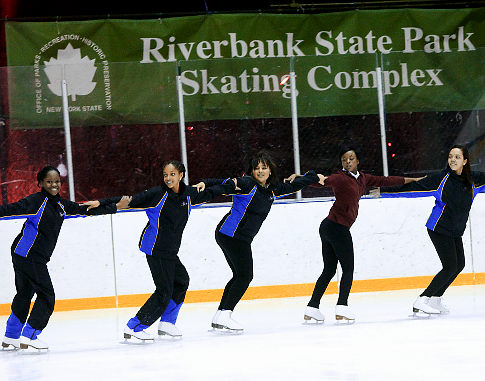Bitter faceoff at Harlem ice rink

Many Harlem residents think their children are being squeezed out of a state park built for the neighborhood to make room for wealthy private-school kids from Manhattan and Riverdale.
The issue is the ice rink at Riverbank State Park, the 28-acre facility that opened in 1993 atop a city wastewater treatment plant.
Riverbank’s rink has become the center of a bitter faceoff over gender and racial equity in our public parks – with some local residents threatening a civil rights suit.
Park officials deny any discrimination. It’s just one of those perennial New York battles over park space, they claim. This conflict happens to pit one local figure skating program against an ice hockey program that attracts boys from across the city.
“Ice time is a rare commodity,” Rachel Gordon, the regional state parks director, said. “You have to balance the needs of all the people who want to use it.”
Parents of kids in the widely acclaimed Figure Skating in Harlem program say all sense of balance has been discarded – and the girls of Harlem are being sacrificed.
“Eighty percent of the rink time is allotted to boys hockey, even though not a lot of children from Harlem play hockey,” parent Denise Tutt said. “It’s a grave injustice to the girls of this community, and we just want the time spread more evenly.”
Sharon Cohen has run the figure skating program for 14 years. She has a huge waiting list but can’t accept more than a 130 girls each year because the park won’t allot her more than 4-1/2 hours of ice time a week.
Yet hockey teams from three elite schools outside the neighborhood – St. David’s on the upper East Side, Columbia Prep on the upper West Side, and Fieldston in Riverdale – all have regular slots at Riverbank, taking up 8-1/2 hours of the highly coveted weekday afternoon period at the rink.
In addition, the park has been expanding its hockey program, with a half-dozen teams consuming 15 more hours during the week and on weekend mornings.
Many of the older children in the park’s hockey program also play on the private school teams.
“You can see when those hockey parents pick up their kids that they’re not from this neighborhood,” one bitter resident said.
Park director Reggie Maywood bristles at any suggestion he favors one group over another.
“I work in a state park,” Maywood said. “Anyone who is a resident of this state is in my catchment zone.”
Peggy Shepard of West Harlem Environmental Action, says “There doesn’t seem to me any memory of why this park is there.”
Back in the 1980s, every neighborhood in Manhattan successfully resisted the construction of a wastewater plant.
The state agreed to build a new park on top of the plant to compensate Harlem residents for accepting the plant and for the inevitable foul odors it would bring.
“To now have community children not being being able to use it is a travesty,” Shepard said.
And the problem is not just on the ice.
“I’ve received complaints that Riverbank’s swimming pool is increasingly being rented to outside groups as well,” she said.
Riverbank is not simply a park. Harlem has lived for nearly 20 years with the odors from that plant. The promises made back then – of a park for the local community – have not been forgotten.
All they want uptown is some equity for their kids.